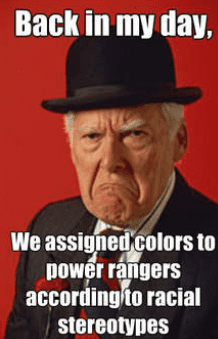 How much misunderstanding and violence does stereotyping create?
How much misunderstanding and violence does stereotyping create?
When the Starbuck’s manager in Philadelphia called the police on Rashon Nelson and Donte Robinson, the “dangerous black man” stereotype was obviously operating. The same stereotype violently surfaced in the police shootings of Michael Brown, Walter Scott, Freddie Gray, Philandro Castile, Tamir Rice, and Akai Gurley.
In a study of black/white confrontation, where the black man shoved the white man in half the videos and the white man shoved the black man in the other half, 75% of the participants said the black man’s shoving was “violent,” and only 17% saw the white man’s shoving that way. Most saw the white man’s shoving as “making a point.” https://blogs.hope.edu/getting-race-right/our-context-where-we-are/the-history-we-inhaled/what-are-the-consequences-of-stereotypes/
So is misunderstanding and violence due to stereotyping 75% of the time? Or 95%? Pick your number. The point is, stereotyping can be dangerous, dehumanizing, and deadly.
A stereotype is a fixed, over generalized belief about a particular group of people. Our brains stereotype automatically by grouping whatever we perceive, and sometimes grouping can be helpful. Not all oncoming cars that swerve over the center line continue in our lane, for example, but when we see one swerving in front of us, most of us steer out of the way. And well we should.
Much of the time, though, stereotypes create problems. When you see an elderly person in the grocery store, you probably expect them to block the aisle while you’re looking for balsamic vinegar, morel mushrooms, and Marsala wine. If you talk with them, though, you might find out they’re as woke as you.
Want to be smart about stereotyping? Keep acting on them when they help, but also have a second option.
Your plan B should be to communicate in ways that help uniquenesses meet. This is anti-stereotyping communication.
Each person is unique. Everybody knows this. Even identical twins with the same DNA have unique experiences and individual tastes and beliefs.
Human individuality surfaces in four ways: in our Choices, Reflections, Emotions-Spirit-Psyche (the un-measurable parts of us), and Mindfulness.
Choices Each of us is distinguished in part by the choices we make—whether to take a risk or stay safe, how to invest our money and time, whether we see the glass as half-empty or half-full. Small choices, like the clothes we wear, and big ones, like whether to have children, mark each of us as an individual.
Reflectionsare our thoughts about thoughts—“Was that a good choice?” “Is this group a waste of my time?” “Is this the right job for me?” “How much should I spend on this?” Every other animal perceives what’s around them, but so far as we know, only humans can perceive our perceptions. Reflections also help make us human.
ESP If you measure every aspect of a person—body temperature, blood pressure, cholesterol counts, height, weight, electric potential in the 8thcranial nerve—you won’t capture who she is. There are un-measurable parts of us, features that are sometimes called emotions, spirit, or personality. We have names for all these—happy, sad, afraid, generous, extrovert—but the names don’t capture these experiences. This is why another part of what makes each of us unique is our unmeasurable parts. I call them “ESP”—emotions-spirit-personality.
Mindfulness Humans are also uniquely able to be mindful, to “Be Here Now.” Buddhists have known this for centuries, and twenty-first century medicine is confirming the value of mindful practices. When you’re communicating, mindfulness surfaces in presentness—being present to the other person and inviting them to be present to you.
The way to reduce or eliminate stereotyping is to help uniquenesses meet in these four ways.
Listen to encourage the other person to put on the table between the two of you some of what makes him or her unique, and talk so that you put some of what makes you unique on the same table.
Start by asking about their choices—“How did you decide to do this?” “What’s most important to you?” “Are you thinking about making a different choice?” In the same conversation, share some of your choices.
Listen for their reflections, too. “What did you think about that meeting?” “Is the group on the right track here?” And put some of your reflections on the table between you—“I like the way the work group’s coming together,” “It seems to me like we’re spinning our wheels,” “I’m expecting things to change in a month or so.”
Can you begin to hear how this focus on choices and reflections can help two people connect as unique persons?
ESP can help, too. Without expecting your conversation partner to wear his heart on his sleeve, ask about feelings, and share some of your own. “I’m worried that the new software will slow production a lot; how do you feel about it?” “Ouch! That sounds like it hurt. Did it?” “This new structure is squashing my creativity. Is it working for you?”
Presentness is communicated mainly nonverbally. Set aside time to talk. Put away your phone and encourage your conversation partner to do the same while you’re talking. Sit across a corner rather than across a table, or better yet, sit some place where there’s no furniture between the two of you. Smile. Make frequent eye contact. Give the other person time to talk, especially if they’re more deliberate than you, or they say less. Be sure the space between you and your posture encourage listening and talk.
In all these ways—and others—listen and talk so that the two of you get on the table aspects of what makes each of you an individual—your choices, reflections, ESP, and mindfulness.
You can’t stop stereotyping just by reminding yourself not to do it. It’s too natural a part of how our brains work. Instead, you have to replace it with another kind of communicating—helping uniquenesses meet.
You can find another, more elaborated explanation of these ideas and skills in the first 33 pages of my book, Personal Communicating and Racial Equity.
You can get an ebook or hard copy for $12.95 at https://he.kendallhunt.com/product-listing?search_api_views_fulltext=&search_api_views_fulltext_1=&search_api_views_fulltext_3=personal+communicating+and+racial+equity&field
For an audiobook version, go to https://www.amazon.com/Personal- Communicating-and-Racial-Equity/dp/B01MAZEKQ1/ ref=sr_1_1_twi_audd_2?s=books&ie=UTF8&qid=1529263415&sr=1-1&keywords=personal+communicating+and+racial+equity.


